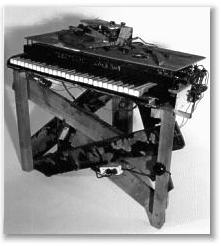Fred, thanks for bringing our conversation over here. Others are probably silently thanking you as well, I'm yacking about it too much.
If you go back 9 posts in this thread I covered this in some detail because I wanted to get in one spot my current thinking about the two ways I know of to make a Theremin oscillator with EQ coil. I'm likely using different (or wrong!) terminology, but there are a variety of way to generalize, conceptualize, and describe oscillator and filter networks. I had some networks and control theory classes back in college, but the capacity to learn tragically carries with it the equal or greater condition of slowly, constantly forgetting everything we aren't using day to day.
Mode 0: If you look at the topology from input to output, there is a series L, C to ground, series L, C to ground, which is the form of a 4th order low pass filter (which is why I label it LPF). As implemented it is minimally damped, so simulation shows a transfer function of two resonant peaks and two resonant dips, though it does display large scale LPF behavior. The lowest frequency resonant peak has the highest voltage at the antenna, most sensitivity, and clearest phase quadrature at resonance, so this is the one I use. Tuning is so uncritical I don't need any variable components (I can't stress enough how important this is). Output voltage swing is completely determined by the input voltage swing and input drive resistor value. Input drive is low impedance and the voltage swing can be quite small - the AFE presently has 5V p-p drive (I'll probably be dropping this to 3.3V to be more compatible with less old logic) through a 4.7k drive resistor, which develops ~50V p-p in the tank and >100V p-p at the antenna.
I've had the best results so far with a very small tank capacitance (currently 10pF) and very large, roughly equal inductors for the tank and EQ inductors (currently 100mH each, just got the 50mH Bournes 6310 and haven't tried them yet, but they look purdy). The EQ inductance can be somewhat larger than the tank inductance, but if it's too much larger the quadrature resonance point isn't clear in simulation and the DPLL won't lock (though I've only played with this scenario for a couple of hours or so on the bench).
A mode 0 circuit can also be used for the volume side, possibly with no EQ coil, thus saving some money and simplifying things a bit (as well as raising the frequency somewhat higher that of the pitch side if identical inductors are used throughout the Theremin tuned circuitry). Two or more mode 0 circuits with closely matching component values can be identically driven (through separate resistors) from a single source, giving multi-dimensional gesture control. If one is designing a two dimensional controller, the two networks could possibly be driven 180 degrees out of phase, lowering overall emissions and therefore minimizing disturbance to the frequency side of things. I'll be investigating this in the coming weeks, but I think you've already done something highly similar to this Fred.
Mode 1: The topology with the parallel LC tank is more like a bandpass filter coupled to a peaky low pass filter. Drive is high impedance (open collector in the EW). I believe the tank and EQ leg resonances need to be tuned to the same (or nearly the same) frequency in order for it to work properly. This means you need at least one tunable element somewhere in the filter network (tank coil, EQ coil, tank cap, antenna geometry, etc.) and it won't automatically give you maximum voltage swing at the antenna without some fiddling. This to me is the huge downside of mode 1 because it negatively impacts manufacturability and long term maintenance / stability.
~~~~~~~~~~~~~~
Regarding topology and linearity, I experience many quite linear octaves with my mode 0 AFE. The two octaves nearest the antenna are somewhat cramp (perhaps 2:1 for the penultimate) and almost ultrasonic at the top. If I carefully set the offset (local oscillator heterodyne frequency if this were an analog Theremin) and use my unmoving body as the final point for my pitch hand, it can go almost subsonic before the linearity finally poops out (as it must, because you can't logarithmically hit the null point of zero Hz).
I don't think this fairly linear-ish behavior is exclusive to mode 0 but I could be wrong. I used to think linearity favored certain topologies but now I think it's mistuned mode 1 oscillators and/or poorly implemented EQ networks that are the cause of much of the trouble out there.


